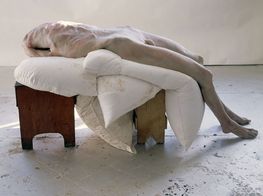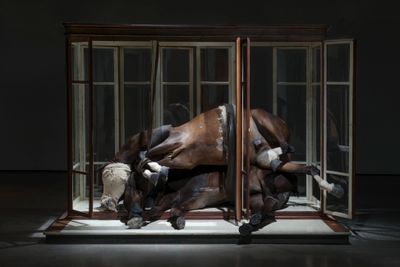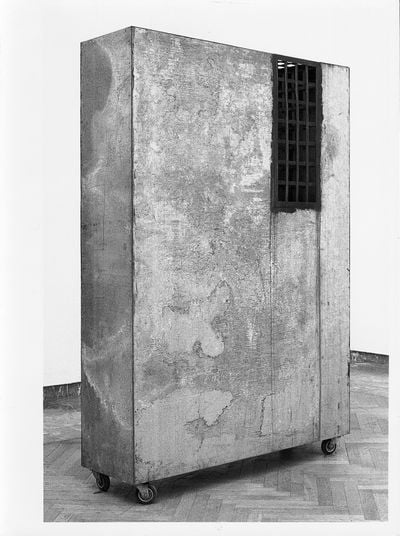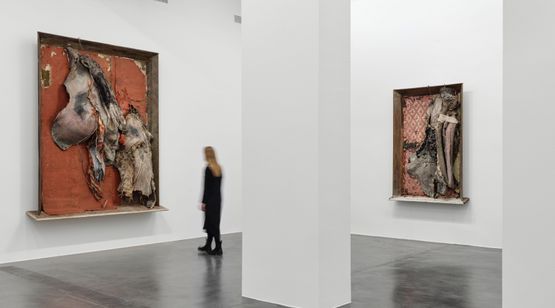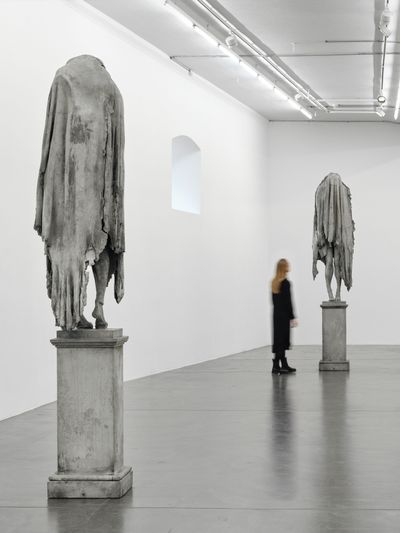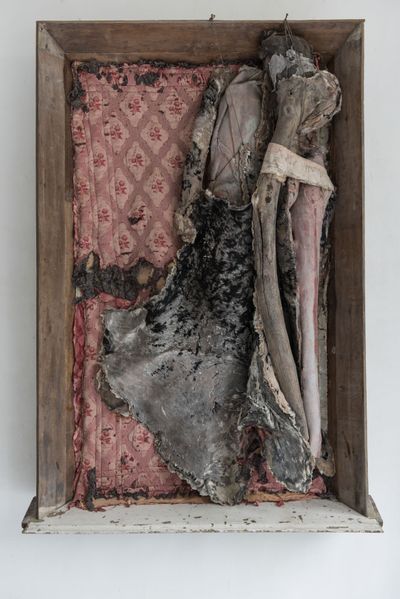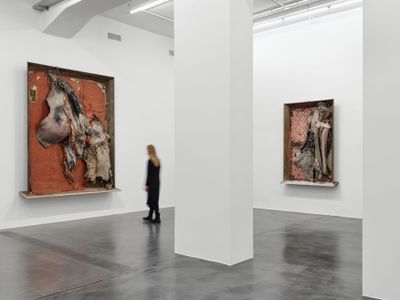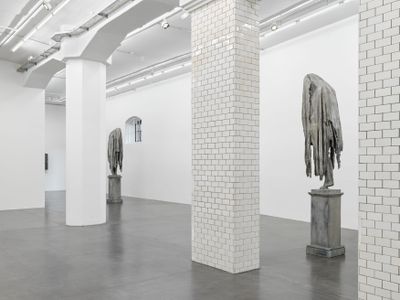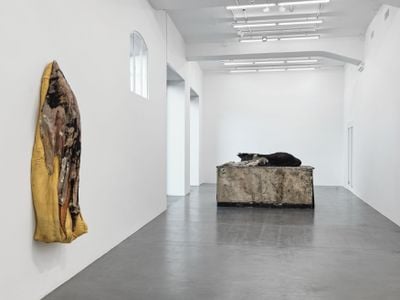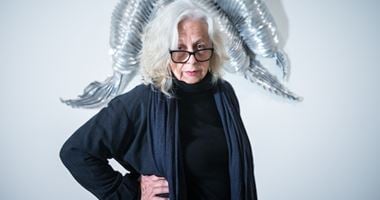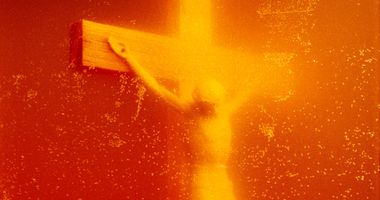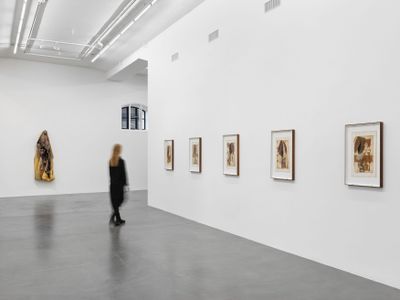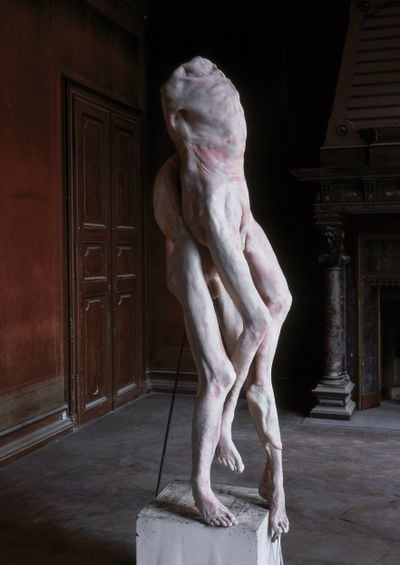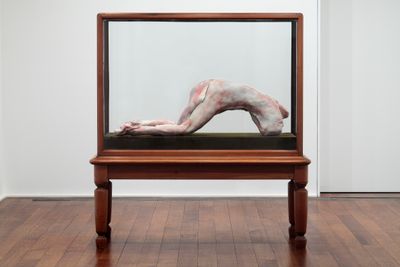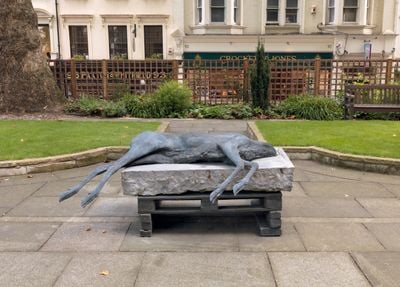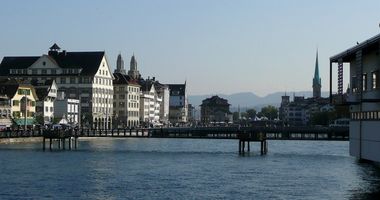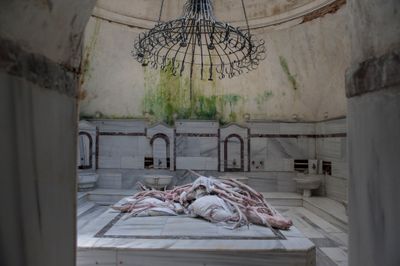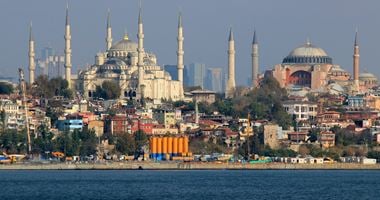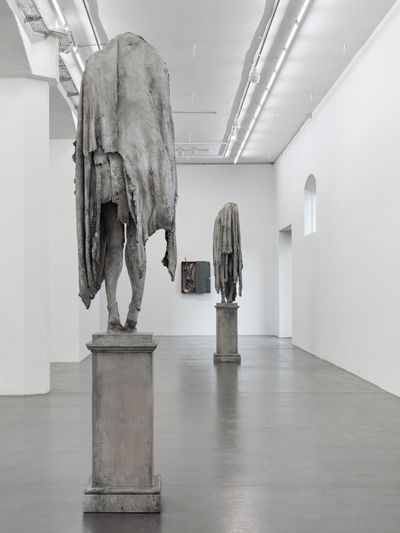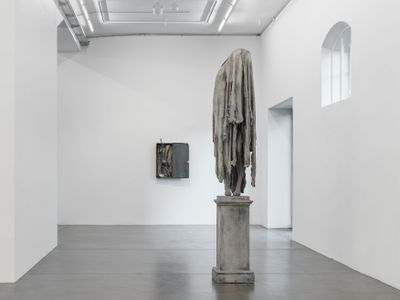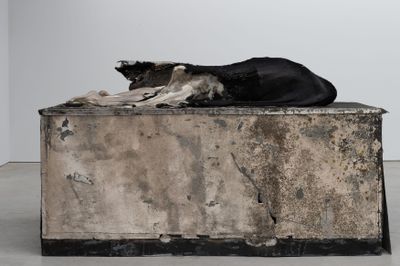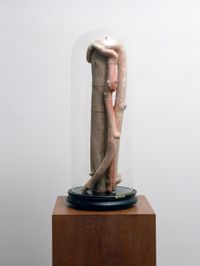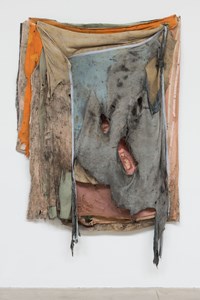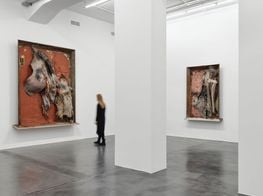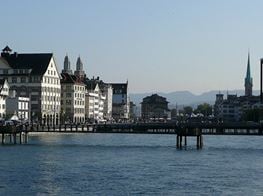Berlinde De Bruyckere: What’s Divine Is Never Simple
Berlinde De Bruyckere. © Berlinde De Bruyckere. Courtesy the artist and Hauser & Wirth. Photo: Thomas Dashuber/Diözesanmuseum Freising.
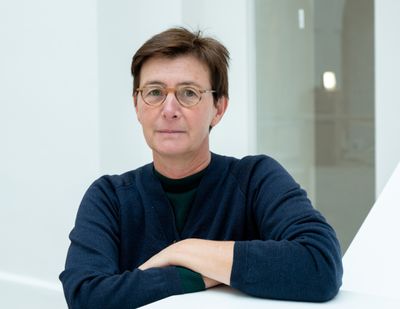
Berlinde De Bruyckere. © Berlinde De Bruyckere. Courtesy the artist and Hauser & Wirth. Photo: Thomas Dashuber/Diözesanmuseum Freising.
In her sculptures, Belgian artist Berlinde De Bruyckere transfers Christian iconography as well as influences from the Flemish Renaissance and European Old Masters into expressions of the human condition.
They are acts of transgression, gathering materials including animal skins, wood, metal, and wax into monumental works that radiate a sense of dark and quiet beauty combined with an aura of fragility.
De Bruyckere's use of horse pelts is one such example. In 1999, the artist began researching the archives at the World War I museum in Ypres, Belgium, where she encountered photographs of deceased horses on the battlefield.
The resulting installation In Flanders Fields, 1999-2000 (1999–2000) comprised five horses, two on the floor and three propped up on thin metal stands, their dense bodies made vulnerable and helpless with key facial and bodily features entirely smoothed over.
Later sculptures such as Marthe, 2008 (2008) and Pietà, 2007 (2007) make explicit reference to the body once more. Here, humanoid figures appear in a state of metamorphosis, crafted in wax and epoxy. In Marthe, 2008, a figure steps forward, its head replaced by a mass of tangled branches that tumble to the floor.
Solitude is keenly felt in these works, where bodies appear to amble without aim, or are burdened by their own physicality. While the body is explicitly referenced in these sculptures, it is sometimes implicitly layered into De Bruyckere's works through materials rather than form.
This began with her early 'Cage' sculptures of the 1990s—steel structures that sometimes contained blankets inside. De Bruyckere explains the role of the blanket to provide 'comfort and hope'. As an object that mimics the skin, it is close to life itself.
Having attended boarding school at a young age, De Bruyckere's interest in finding universal expressions for religious themes began with her childhood inquiries into Christianity. She recalls looking at representations of the life of Christ at school, noting that these encounters represented her first contact with mysticism, rather than religion.
At her solo exhibition at Hauser & Wirth in Zurich, A simple prophecy (26 January–13 May 2023), a new series of 'Arcangelo' sculptures made of bronze, lead, and chrome steel depict angels shrouded in cast metal skins. With their faces hidden from sight, they are private, inward-looking figures.
De Bruyckere began the 'Arcangelo' series during the pandemic, having observed images in the media of nurses caring for the sick. It considers 'how much an angel might be able to take on before it falls', with one among them lying on a long plinth like an 'enormous, wounded black bird'. The blanket appears in this series as well as her other recent body of works, 'It almost seemed a lily' (2017–ongoing), inspired by the Enclosed Gardens—16th-century private altars handcrafted by nuns in Mechelen.
Amongst the abundance of artefacts gathered in the Enclosed Gardens, De Bruyckere was captivated by fragile depictions of lilies. In her series, the flower becomes enlarged and abstracted, with wooden frames encasing blankets and bone-like forms, as in the flesh-pink It almost seemed a lily V, 2018 (2018).
While flowers are a new subject for the artist, the series marks a return to the body's oblique referencing. It occurs through layers of materials and themes, and enables a resonance between each work in the exhibition.
The title, A simple prophecy, is a line drawn from the poem 'Preliminary Investigation of an Angel' by 20th-century Polish poet Zbigniew Herbert, which considers the transgression of the divine to the profane by drawing parallels between totalitarian regimes and biblical mythology.
Between the carnal and grotesque; beauty and frailty, this conversation touches on some of the key themes and concerns in De Bruyckere's latest works.
TMYour works at Hauser & Wirth feel like a return to your early cage sculptures from the 1990s that implicitly dealt with the body by pronouncing its absence through materials such as blankets. To what extent do you feel that is true, particularly in your series 'It almost seemed a lily'?
BDBI don't know if you can call it an evolution—I feel very deeply that the topics in my work are not changing. The early cages are made of steel and are very cold, but the intent was for the viewer to make their own reading of the work—that you could open the cage and find freedom, or see the cage for its limitations.
If you look at the 'Arcangelo' figures, you can see that they don't have faces and are completely protected by the cast skins that drape over their heads. In a sense they are imprisoned in themselves. They are very introverted, and I think this is a quality that exists in all of my work.
I go deeper into topics by using different materials. There is a resonance that exists between them—the same material might be read differently in another work.
TMYour work transfers themes and iconography from Christianity, Flemish Renaissance, and European Old Master paintings. Would you say the origin of this exploration was your experience at boarding school?
BDBI went to boarding school between the ages of 5 and 15, I was very young. I don't have any siblings, so I was already on my own at home. I had a lot of friends at school, since we were all going through the same experience, but at the same time the loneliness was very pronounced.
I couldn't put into words what I was missing, but I felt this was not a normal way to grow up, amongst all these nuns with strict rules, and going to chapel every morning to pray. I remember sitting in church and seeing all these paintings telling stories from the Bible. As a child, I didn't really understand what I was looking at. I felt it was my first contact with mysticism, rather than religion.
What I experienced there became very visible in my work. I tried to express in my own language themes from Christianity, to try and talk about our society. My use of blankets is linked to that.
What religion should do is give you some comfort and hope, and help with your anger and fears. This is exactly what blankets do. Much more than a material, they are objects—objects that are very close to our skin and to our life, particularly our intimate life, since everything begins on the bed.
TMThere is this notion of eroticism too, which comes in contrast with notions of purity associated with Christian faith.
BDBIt was only recently that I began going deeper into these erotic themes. In 2017 I was researching the Enclosed Gardens of Mechelen, which I encountered at an exhibition at Leuven. I was blown away by these personal altars that were made by and for the nuns that cloistered themselves away and never came out.
The nuns received lots of precious objects and materials from citizens, including relics, beautiful silks, and small sculptures that they integrated in the altars. In my work, I also make use of old materials, such as furniture, vitrines, fabrics, and skins. I bring in objects that have histories and write stories on top of them in a process of transgression.
I was thinking about the nuns, who didn't have access to the outside world and perhaps wanted to make their own gardens of Eden. I imagined them adding luscious, handcrafted fruits and flowers to these private altars, longing to add more and more, to see them grow, and become more precious, more beautiful.
Imagining the nuns, who were guided by stories about the body of Christ, was very interesting to me in making this work. I translated the thin flowers made of silver thread and silk, and enlarged them to make these feelings of lust and desire more visible.
Most of my works are to scale, so when it came to recreating the flowers, I decided to make casts of the skins I had in the story. I thought I could translate the feeling of skin, with its soft texture like the petal of a flower, and use that in my work.
TMIn contrast to the fragility you speak of in relation to the dying flowers, there is also a sense of abundance, in the way you describe the nuns accumulating materials. That contrast exists in the lily as a flower that, as it withers and dies, expels the most pungent of smells, for instance.
It is a remarkable feature of your works—their materials might be considered old and fading away, but they are then accumulated into these masses and forms that speak of the body.
BDBI feel that my interpretations of the Enclosed Gardens are very bodily since they are so huge and abstract; you forget that you are looking at the flower. Many people don't see flowers when they look at them, they see bodies, and I can completely understand that.
When I first approached this theme of a flower in decay, nobody was expecting it. Looking at the works, people searched for bodies, particularly because of the pinkish tones. I like that there is a human quality to them.
TMThere are elements of colour visible in your sculptures, whether the pinkish-blue tinged skin of Pietà, 2007 and Marthe, 2008, or similar tones present in the monumental Aletheia, on-vergeten, 2019 (Truth, unforgotten) (2019), which consists of piles of wax casts of animal pelts. These painterly elements seem to recall references to the Old Masters. How would you describe your approach to painting?
BDBUntil around 2007 I was more interested in sculpture, but at a certain point, I read about how the 15th-century Flemish painter Hugo van der Goes delicately painted skin through transparent and very living layers of oil paint. I tried to copy what I saw in his paintings in wax, and I think that's when I became aware of the pictorial quality of sculpture.
For Into One-Another, 2010-2011 (2010–2011), I created these sculptures of bodies merging together, and for the first time incorporated this red colour to demonstrate the physical pain of that process. During that time I realised that painting was as important as sculpture in the shaping of the work.
TMYour sculpture Rodt, 6 januari, 2012 (2012) was one of your first to be exhibited outdoors. I wondered whether your works necessitate the quiet aura of the gallery or museum to elevate their impact?
BDBYes, before that the outdoor works I did were usually in-situ installations or commissions. With works commissioned for a specific garden or park of a collector, I always took the environment with me in the making process.
It takes a lot of time to visit collectors and learn about the seasonal differences in a garden, for example. It means visiting at least four times to see changes across the seasons. For the two new bronze and lead sculptures I created for the exhibition in Zurich, the starting point was different. They can be installed both inside and out.
If the environment changes, then the reading changes. For my first solo exhibition in Istanbul in 2012, for instance, I created work for the city's historic Çukurcuma Hamamı. I was invited by a collector who has a museum there, but I wanted to show my work in a place that reflected the layered nature of the city as a melting pot of cultures and religions.
TMHow was your experience using bronze and lead for the first time for the 'Arcangelo' sculptures?
BDBI like it very much. Lead is very heavy yet flexible, soft yet poisonous. It has a lot of contradictions, and I think this fits my work well. It was the perfect material to use instead of wax for these outdoor works—they develop an orange-white patina and become even more beautiful.
I was not able to create them in 100 percent lead because of the balance of the sculptures. They have to sustain a lot of weight, so there was a lot of engineering involved. We did a lot of research and decided to create this lead layer on the bronze. We placed a sample outside for two years to see the material's interaction with the elements, and it changed in a very natural, beautiful way.
TMIt's interesting to think of these silent figures as potential harbours of illness and death, with the lead, and to link that with their creation during the pandemic. How much are they informed by Covid-19?
BDBI started to work with them during Covid-19. The painting by Giorgione, Cristo morto sorretto da un angelo (c. 1502–1510), depicts the body of Christ being taken by an angel with these big, dark wings that look so soft and beautiful. The angel's face is partly visible, and it made me look at the body of Christ in a completely different way.
At the time, people were entering hospitals with Covid-19 and dying, often alone. For me, that is the worst thing I could possibly imagine. I saw images in the media of nurses taking care of sick people, and started to create these sculptures. I was also thinking about how much an angel might be able to take on before collapsing. The last piece depicts an angel lying down on the ground like an enormous, wounded blackbird.
It's not an angel of death, but an angel that is tired after carrying the weight of our sorrows. That angel exists in its own space, but ties into other works in the exhibition. It's a nice note upon which to end the show, with that sculpture—to walk around the space and to see it in a new light through the others. —[O]

